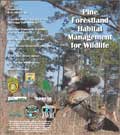Game Animals
Non-game Animals
Habitat
Eastern Wild Turkey
Meleagris gallopavo
- The most common turkey species
- Require a variety of habitats including open land and forests
- Require ample cover for best survival
Species Description: Eastern Wild Turkey
Eastern wild turkeys are the most abundant and hunted of all the U.S. turkey species. They require a variety of habitats including open lands and forests. Adequate forestland is necessary to maintain their populations. They generally prefer hardwood and mixed forests with 15 to 65 percent open area which includes fields, cropland and pastures.
Good habitats provide plentiful fruit, seeds, insects and vegetation for turkeys to consume. Turkeys also need roosting areas within forested habitats. They prefer to roost in conifers in close proximity to water and on ridgetops or knolls.
Turkeys’ predators include snakes, skunks, dogs, coyotes, rodents, possums, hawks, owls, fox and raccoons. They are more vulnerable to predators if ground-level vegetation is sparse. Eastern wild turkeys have a better chance of survival in a suitable habitat with ample food sources and with good cover.

Forest Management for Wild Turkeys (PDF)
Mississippi State University Extension Service
A variety of habitat types are necessary for wild turkeys, including forests, old fields and open lands. This publication describes habitat needs for turkeys including seasonal needs, the effect of roads on turkeys, and their water requirements. A list of tips on bettering the habitats of wild turkeys is included. Information is given on how to maintain pine plantations, mixed upland pine-hardwood forests and bottomland hardwood forests for the benefits of turkey. A chart on foods by habitat type is provided.

Supplemental Wildlife Food Planting Manual for the Southeast (PDF)
Mississippi State University Extension Service
This guide provides information on food plots and habitat management practices including disking, mowing and prescribed burning. The importance of openings is also discussed. A combination of supplemental forages in food planting is often necessary, as well as testing soil quality, fertilizing and liming. The location, size and shape of food plots as well as how to prepare them and which plants to use is included. An extensive guide on planting materials is given.

Pine Forestland Habitat Management for Wildlife (PDF)
Mississippi State University Forest and Wildlife Research Center
Pine forests can be managed to provide wildlife habitat using a variety of techniques, some of which can improve timber stand quality. Established stands can be managed with thinning, prescribed fire or disking, and even herbicide control of hardwoods which can provide food and cover for quail and grassland species, deer, rabbits, turkey and other wildlife. Regenerating stands can be managed to provide weeds, legumes, and grasses that benefit quail and other early successional wildlife species. Even former agricultural fields can be managed for grassland habitat in conjunction with pine production to include wildlife habitat.
Truths and Myths about Wild Turkey (PDF)
Purdue University Extension
Perceived conflicts between humans and wild turkeys over crop damage and turf damage are discussed and myths are dispelled. Turkeys do not create measurable crop damage and are often blamed due to their daytime presence in fields damaged by other wildlife or livestock.
Standing dead trees are called snags. They often have cavities or holes in them that provide nesting habitat and homes for birds, food and homes for woodpeckers, homes for salamanders and frogs and a multitude of insects.

